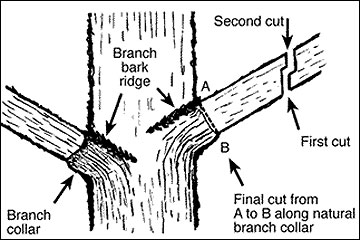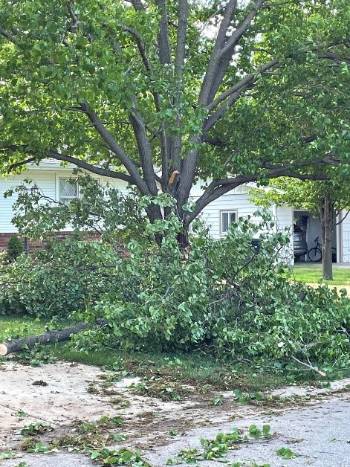Storm Damage to Trees

Unfortunately, severe weather is going to continue to happen either in the winter or the summer, we do live in Kansas after all, and while we can’t control the weather we can have the tools in place to handle the aftermath. Your first priority should be any dangling limbs or limbs that are barely connected to the tree. These limbs can easily fall, hurt people or property and should be removed ASAP before you do anything else with the tree. After you have removed the hazards it’s time to take a break and deal with other issues. The trees, for the most part, have stood for years and waiting a few days or weeks will not hurt them in the long run. Often our first thought is to immediately get the tree taken care of, and while that’s important to do if the tree or branches pose a danger to humans or property, general pruning can wait.
The second step is to assess the damage done and determine the best steps to handle it. Damage to trees can range from just a few small broken limbs to major structural damage. Once you have checked the area for any safety concerns (powerlines, dangling limbs, etc) look over the tree. Trees that are missing less than 50% of their canopy and have little damage to the main trunk or major limbs will survive and be just fine with some pruning. Once a tree has lost more than 50% of it’s canopy it becomes a bit trickier to determine if a tree can be salvaged or not. If the main structure of the tree is still intact (trunk and main limbs) then the tree could potentially be saved but that depends on the sentimental value of the tree, how much it would cost to replace it and the health of the tree before the storm. Trees like the one above will need removed with the main structure being broken.
Once you have assessed the damage done to the true and have determined what needs to be pruned out it’s time to clean up the tree. Before doing that first ask yourself if you feel comfortable doing the pruning, how high up in the tree you have to get and how big of limbs you need to prune. It maybe best to hire a professional arborist for pruning high in the tree and dealing with large limbs. When pruning branches that are over 3” in diameter I recommend using the three cut method to prevent tearing the bark (see photo below). The first cut is on the bottom side of the limb about a foot or so from the trunk, this cut prevents the bark from tearing when the limb falls off. The second cut is from the top is 2-3 inches beyond the first cut and goes all the way through the limb. This cut removes most of the weight from the branch and makes it easier to handle. The last cut is just beyond the branch collar which is where a slight swelling is or wrinkle in the bark on the tree. This collar contains the cells to heal the branch after the cut. If bark was torn when limbs broke off during the storm prune off the loose bark back to where it is solidly attached to encourage growth and healing. Wound treatments are not needed when pruning branches and, in some cases, can slow the healing of the plant.

Commonly trees will be blown over in storms and while large trees that have fallen over cannot be saved, smaller trees with at least ½ of their roots still in the ground could be pulled back upright and staked. Before the tree is pulled upright, remove some soil from the hole so the roots are back below the ground level. Once the tree is pulled back up cover the roots with dirt as needed. Stake the tree using 2-3 lines. After a disaster and a tree has been damaged it is very common for people to want to pamper their tree and give it extra attention while it is recovering. This can actually cause more issues for our trees. If your tree is in your yard and you are fertilizing your lawn, your tree is getting all the nutrients it needs and extra fertilizer will not help it recover. Most trees will survive without extra water, however if we go into a dry spell it can be beneficial to water your tree once a week or so but if you are already watering your lawn, your tree will be just fine. Our trees are very resilient and very little care is needed after a storm to help them survive. It is important to keep an eye on damaged trees for several years after the storm as insects and diseases are more likely to infect trees that are stressed from the damage. While there are chemicals you could apply they likely would do more harm than good in the long run. If you do start seeing an issue first get it diagnosed so you are able to treat it properly, then treat.


Have questions? Contact our office where our Horticulture Extension Agent will assist you with questions.
Phone: (316) 321-9660
Email: callae@ksu.edu